PVC Detection through a Hybrid SEIRA Substrate and Refractive Index Sensor Based on Metamaterial Perfect Absorbers
Abstract
:1. Introduction
2. Materials and Methods
3. Results
4. Conclusions
Author Contributions
Funding
Institutional Review Board Statement
Informed Consent Statement
Conflicts of Interest
References
- Aroca, R.F.; Ross, D.J.; Domingo, C. Surface-Enhanced Infrared Spectroscopy. Appl. Spectrosc. 2004, 58, 324A–338A. [Google Scholar] [CrossRef]
- Enders, D.; Pucci, A. Surface enhanced infrared absorption of octadecanethiol on wet-chemically prepared Au nanoparticle films. Appl. Phys. Lett. 2006, 88, 184104. [Google Scholar] [CrossRef]
- Wang, H.; Kundu, J.; Halas, N.J. Plasmonic Nanoshell Arrays Combine Surface-Enhanced Vibrational Spectroscopies on a Single Substrate. Angew. Chem. Int. Ed. 2007, 46, 9040–9044. [Google Scholar] [CrossRef] [PubMed]
- Neubrech, F.; Pucci, A.; Cornelius, T.W.; Karim, S.; García-Etxarri, A.; Aizpurua, J. Resonant Plasmonic and Vibrational Coupling in a Tailored Nanoantenna for Infrared Detection. Phys. Rev. Lett. 2008, 101, 157403. [Google Scholar] [CrossRef] [PubMed] [Green Version]
- Miroshnichenko, A.E.; Flach, S.; Kivshar, Y.S. Fano resonances in nanoscale structures. Rev. Mod. Phys. 2010, 82, 2257–2298. [Google Scholar] [CrossRef] [Green Version]
- Lu, W.-T.; Wang, S.-J.; Li, W.; Wang, Y.-L.; Ye, C.-Z.; Jiang, H. Fano-type resonance through a time-periodic potential in graphene. J. Appl. Phys. 2012, 111, 103717. [Google Scholar] [CrossRef]
- Cheng, F.; Yang, X.; Gao, J. Ultrasensitive detection and characterization of molecules with infrared plasmonic metamaterials. Sci. Rep. 2015, 5, 14327. [Google Scholar] [CrossRef] [PubMed] [Green Version]
- Ma, W.; Xu, L.; Wang, L.; Kuang, H.; Xu, C. Orientational nanoparticle assemblies and biosensors. Biosens. Bioelectron. 2016, 79, 220–236. [Google Scholar] [CrossRef]
- Chang, Y.-T.; Lai, Y.-C.; Li, C.-T.; Chen, C.-K.; Yen, T.-J. A multi-functional plasmonic biosensor. Opt. Express 2010, 18, 9561–9569. [Google Scholar] [CrossRef] [PubMed]
- Tang, S.; Fang, Y.; Liu, Z.; Zhou, L.; Mei, Y. Tubular optical microcavities of indefinite medium for sensitive liquid refractometers. Lab Chip 2015, 16, 182–187. [Google Scholar] [CrossRef]
- Sugawa, K.; Tahara, H.; Yamashita, A.; Otsuki, J.; Sagara, T.; Harumoto, T.; Yanagida, S. Refractive Index Susceptibility of the Plasmonic Palladium Nanoparticle: Potential as the Third Plasmonic Sensing Material. ACS Nano 2015, 9, 1895–1904. [Google Scholar] [CrossRef]
- Lai, Y.-C.; Lee, H.-C.; Kuo, S.-W.; Chen, C.-K.; Wu, H.-T.; Lee, O.K.; Yen, T.-J. Label-Free, Coupler-Free, Scalable and Intracellular Bio-imaging by Multimode Plasmonic Resonances in Split-Ring Resonators. Adv. Mater. 2012, 24, OP148–OP152. [Google Scholar] [CrossRef]
- Li, C.-T.; Lo, K.-C.; Chang, H.-Y.; Wu, H.-T.; Ho, J.H.; Yen, T.-J. Ag/Au bi-metallic film based color surface plasmon resonance biosensor with enhanced sensitivity, color contrast and great linearity. Biosens. Bioelectron. 2012, 36, 192–198. [Google Scholar] [CrossRef]
- Lee, Y.; Kim, S.-J.; Park, H.; Lee, B. Metamaterials and Metasurfaces for Sensor Applications. Sensors 2017, 17, 1726. [Google Scholar] [CrossRef] [Green Version]
- Abdulkarim, Y.I.; Deng, L.; Karaaslan, M.; Dalgaç, Ş.; Mahmud, R.H.; Alkurt, F.O.; Muhammadsharif, F.F.; Awl, H.N.; Huang, S.; Luo, H. The Detection of Chemical Materials with a Metamaterial-Based Sensor Incorporating Oval Wing Resonators. Electronics 2020, 9, 825. [Google Scholar] [CrossRef]
- Zulfi, A.; Rezeki, Y.A.; Edikresnha, D.; Munir, M.M.; Khairurrijal, K. Synthesis of Fibers and Particles from Polyvinyl Chloride (PVC) Waste Using Electrospinning. IOP Conf. Ser. Mater. Sci. Eng. 2018, 367, 012014. [Google Scholar] [CrossRef] [Green Version]
- Narita, S.; Ichinohe, S.; Enomoto, S. Infrared spectrum of polyvinyl chloride. I. J. Polym. Sci. 1959, 37, 273–280. [Google Scholar] [CrossRef]
- Chen, C.-Y.; Un, I.-W.; Tai, N.-H.; Yen, T.-J. Asymmetric Coupling between Subradiant and Superradiant Plasmonic Reso-nances and Its Enhanced Sensing Performance. Opt. Express 2009, 17, 15372–15380. [Google Scholar] [CrossRef]
- Guo, L.; Chen, L.; Hong, S.; Kim, D.-H. Single plasmonic nanoparticles for ultrasensitive DNA sensing: From invisible to visible. Biosens. Bioelectron. 2016, 79, 266–272. [Google Scholar] [CrossRef]
- Park, S.J.; Hong, J.T.; Choi, S.J.; Kim, H.S.; Park, W.K.; Han, S.T.; Park, J.Y.; Lee, S.; Kim, D.S.; Ahn, Y.H. Detection of microorganisms using terahertz metamaterials. Sci. Rep. 2014, 4, 4988. [Google Scholar] [CrossRef] [PubMed]
- Nasir, M.E.; Dickson, W.; Wurtz, G.A.; Wardley, W.; Zayats, A.V. Hydrogen Detected by the Naked Eye: Optical Hydrogen Gas Sensors Based on Core/Shell Plasmonic Nanorod Metamaterials. Adv. Mater. 2014, 26, 3532–3537. [Google Scholar] [CrossRef]
- Chen, X.; Fan, W. Ultrasensitive terahertz metamaterial sensor based on spoof surface plasmon. Sci. Rep. 2017, 7, 1–8. [Google Scholar] [CrossRef] [Green Version]
- Wakatsuchi, H.; Greedy, S.; Christopoulos, C.; Paul, J. Customised broadband metamaterial absorbers for arbitrary polarisation. Opt. Express 2010, 18, 22187–22198. [Google Scholar] [CrossRef] [Green Version]
- Fu, J.; Dong, H.; He, J.; Sun, Y.; Jin, Y.; He, S. Enabling Ultrathin Metamaterial Absorbers with Narrow Slits. Adv. Opt. Mater. 2020, 8. [Google Scholar] [CrossRef]
- Landy, N.I.; Sajuyigbe, S.; Mock, J.J.; Smith, D.R.; Padilla, W.J. Perfect Metamaterial Absorber. Phys. Rev. Lett. 2008, 100, 207402. [Google Scholar] [CrossRef]
- Huang, T.-Y.; Tseng, C.-W.; Yeh, T.-T.; Yeh, T.-T.; Luo, C.-W.; Akalin, T.; Yen, T.-J. Experimental realization of ultrathin, double-sided metamaterial perfect absorber at terahertz gap through stochastic design process. Sci. Rep. 2015, 5, 18605. [Google Scholar] [CrossRef] [Green Version]
- Su, D.-S.; Tsai, D.P.; Yen, T.-J.; Tanaka, T. Ultrasensitive and Selective Gas Sensor Based on a Channel Plasmonic Structure with an Enormous Hot Spot Region. ACS Sens. 2019, 4, 2900–2907. [Google Scholar] [CrossRef] [PubMed]
- Le, T.H.; Tanaka, T. Plasmonics–Nanofluidics Hydrid Metamaterial: An Ultrasensitive Platform for Infrared Absorption Spectroscopy and Quantitative Measurement of Molecules. ACS Nano 2017, 11, 9780–9788. [Google Scholar] [CrossRef] [PubMed]
- Pryce, I.M.; Kelaita, Y.A.; Aydin, K.; Atwater, H.A. Compliant Metamaterials for Resonantly Enhanced Infrared Absorption Spectroscopy and Refractive Index Sensing. ACS Nano 2011, 5, 8167–8174. [Google Scholar] [CrossRef]
- Pedroso, C.B.; Santos, M.B. The Lorentz model applied to composite materials. J. Phys. Condens. Matter. 1994, 6, 2395–2402. [Google Scholar] [CrossRef]
- Levi, A.F.J. The Lorentz oscillator model. Essent. Class. Mech. Dev. Phys. 2016. [Google Scholar] [CrossRef]
- Limonov, M.F.; Rybin, M.; Poddubny, A.; Kivshar, Y.S. Fano resonances in photonics. Nat. Photonics 2017, 11, 543–554. [Google Scholar] [CrossRef]
- Hu, F.-G.; Song, J.; Kamgaing, T. Modeling of multilayered media using effective medium theory. Top. Meet. Electr. Perform. Electr. Packag. Syst. 2010, 225–228. [Google Scholar] [CrossRef]
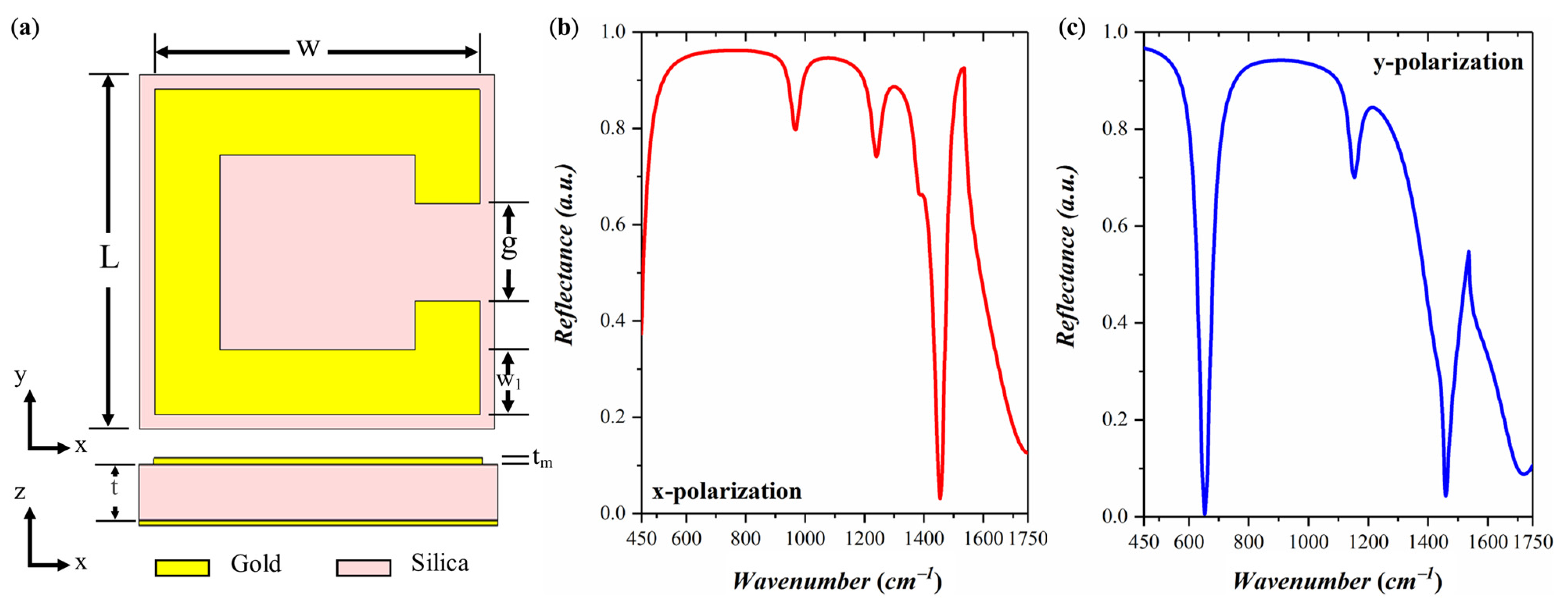
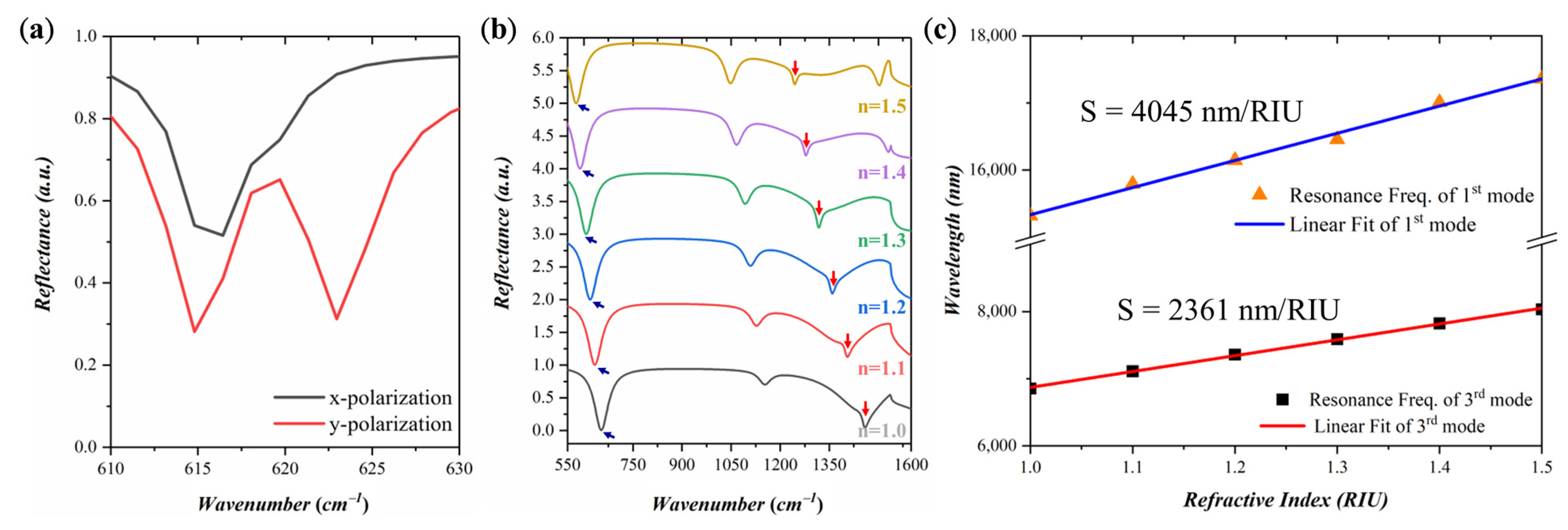
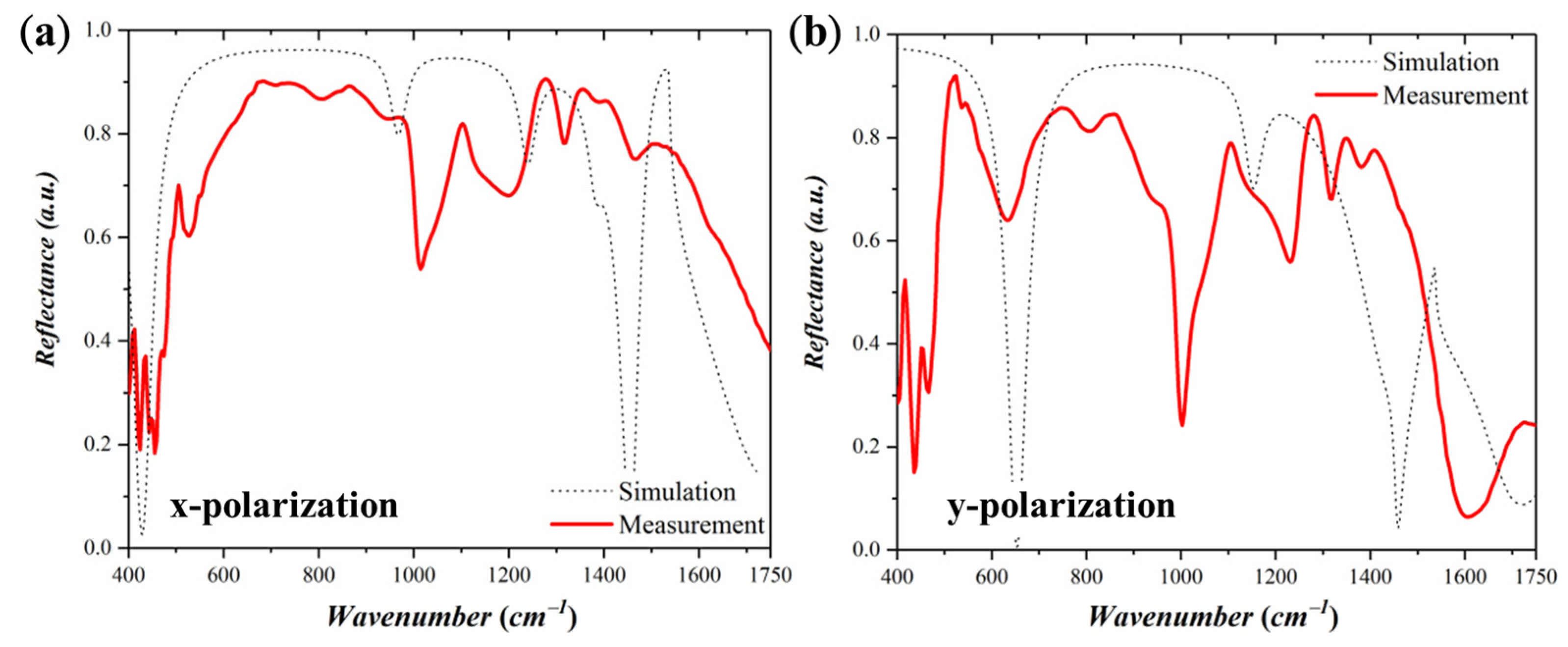
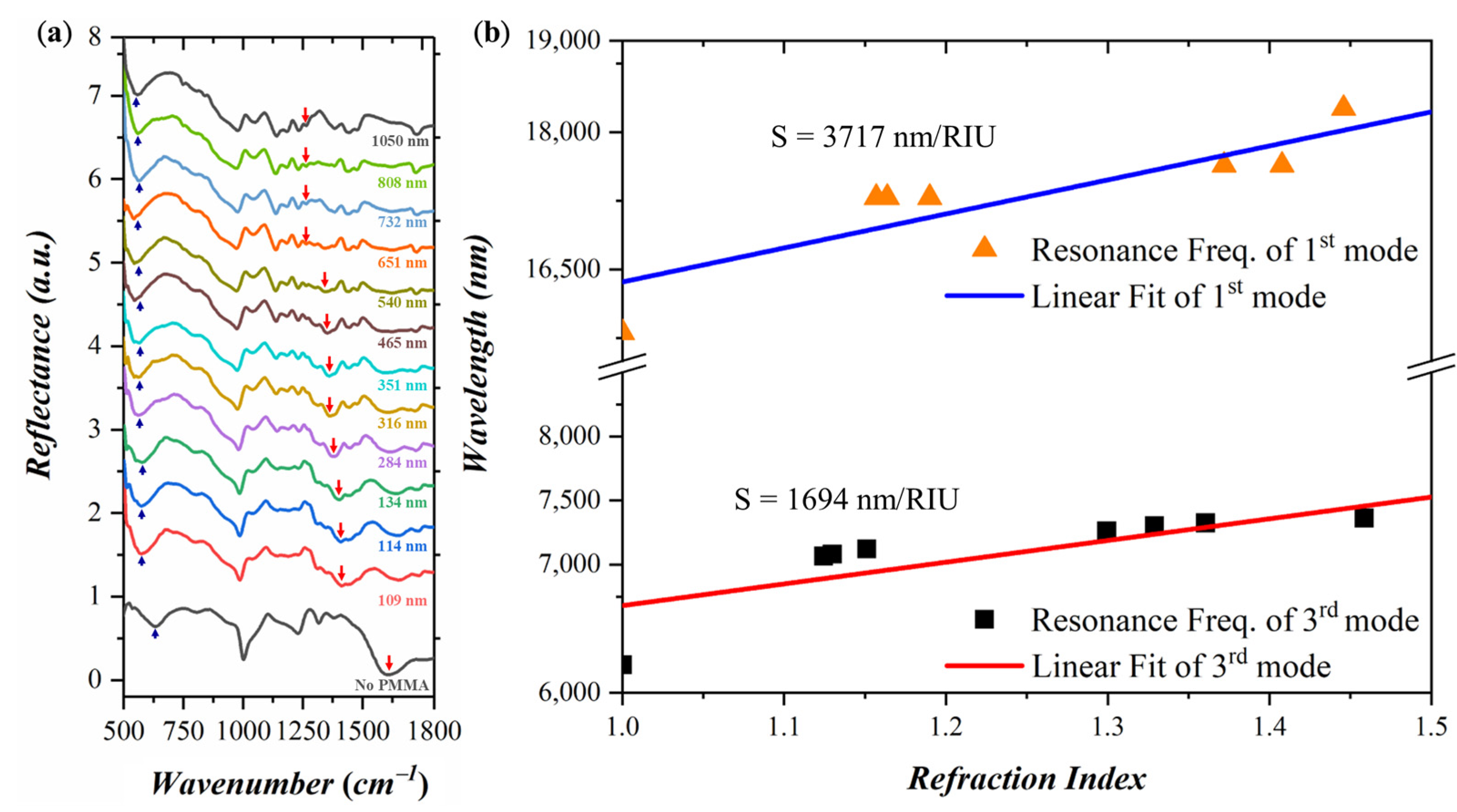
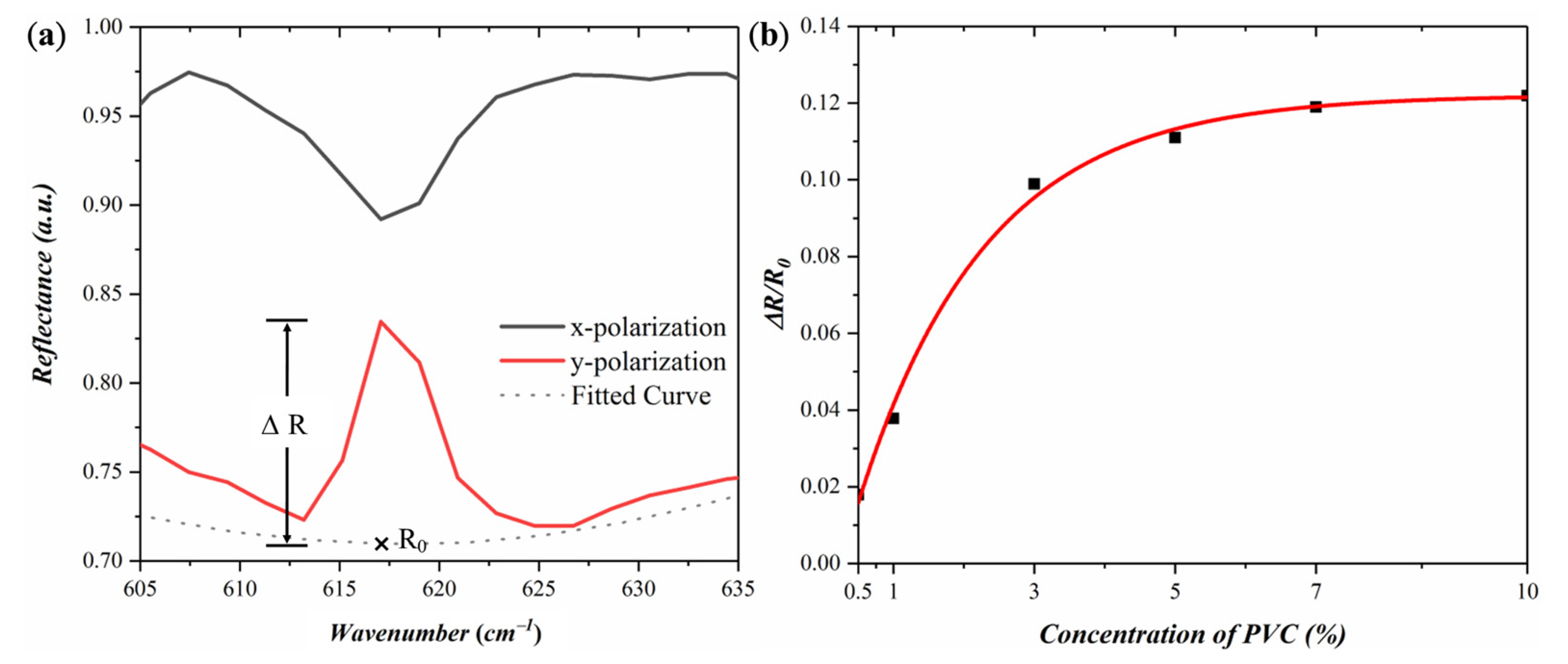

Publisher’s Note: MDPI stays neutral with regard to jurisdictional claims in published maps and institutional affiliations. |
© 2021 by the authors. Licensee MDPI, Basel, Switzerland. This article is an open access article distributed under the terms and conditions of the Creative Commons Attribution (CC BY) license (https://creativecommons.org/licenses/by/4.0/).
Share and Cite
Lin, C.-T.; Yen, T.-J.; Huang, T.-Y. PVC Detection through a Hybrid SEIRA Substrate and Refractive Index Sensor Based on Metamaterial Perfect Absorbers. Coatings 2021, 11, 789. https://doi.org/10.3390/coatings11070789
Lin C-T, Yen T-J, Huang T-Y. PVC Detection through a Hybrid SEIRA Substrate and Refractive Index Sensor Based on Metamaterial Perfect Absorbers. Coatings. 2021; 11(7):789. https://doi.org/10.3390/coatings11070789
Chicago/Turabian StyleLin, Chieh-Ting, Ta-Jen Yen, and Tsung-Yu Huang. 2021. "PVC Detection through a Hybrid SEIRA Substrate and Refractive Index Sensor Based on Metamaterial Perfect Absorbers" Coatings 11, no. 7: 789. https://doi.org/10.3390/coatings11070789
APA StyleLin, C.-T., Yen, T.-J., & Huang, T.-Y. (2021). PVC Detection through a Hybrid SEIRA Substrate and Refractive Index Sensor Based on Metamaterial Perfect Absorbers. Coatings, 11(7), 789. https://doi.org/10.3390/coatings11070789





